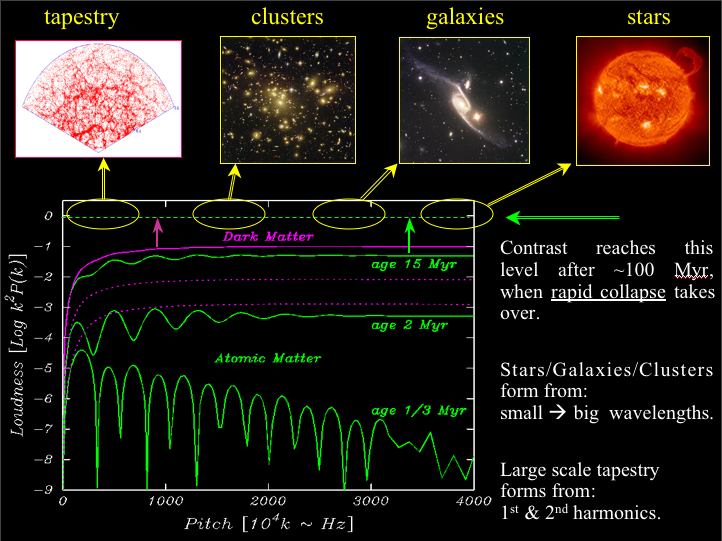
This section explores a brief extension of the current acoustic story, forward in time across 14 billion years to the present day. Our aim is to catch the creation of the most important structures — stars, galaxies, clusters and the cosmic web.
We're approaching the end of our story. Our autobiographical sketch of the Universe's first "year" of life is now complete. Using human metaphor to briefly review, there are three stages: conception, gestation, and birth.... inflation, gravitational growth, and the first burst of star formation. Even the durations match: 12 hours to 9 months to a century is about 400 thousand to 100 million to 14 billion.
Undeniably, though rarely acknowledged, the most crucial and creative moment for all of us was that time when our parental genes were crossing, our deck shuffled, and our hand dealt..... the chance fluctuations of the quantum world were grasped and made real by inflation. From that moment on there was a progressive, almost mechanical, fetal development.... horizons expand, sound develops, fog clears, dark matter provides a womb-like context for coaxing gas into assembling the first stars. An era which opens with almost invisible formless structure ends with a complex landscape on the verge of collapse and transformation. That final transformation from gas into stars is traumatic, emergent, and powerful – it is indeed a birth moment, as cathartic as any organic birth.
That has been our story – the gestation of the infant Universe, from quantum seed, through growth of structure, to final emergence as something we recognize – the start of a subsequent long and complex life – a life we're still living.
If we were telling the tale of a human life, it would absurd to stop the story just as the infant was born – an entire rich life lies ahead, from baby to child to adult to old age. So too with the present story – much unfolds between the first stars and the present day Universe, with its galaxies, suns, planets and people. To tell that story would fill many volumes, so numerous are the characters and so twisting the plot. But we can get a glimpse of its richness if we stick to our principal theme – the ongoing emergence of structures.
The next slide, repeated from topic 11, reminds us that the continuing clumping of dark matter ultimately spawns the birth of several familiar structures – stars, galaxies, clusters, and the cosmic tapestry. One remarkable feature of the form of the initial sound spectrum, P(k) ∝ k, is that all these structures begin growing roughly together – as stars are forming, aggregates of these are gathering, and aggregates of these aggregates are also gathering. Now, although growth occurs simultaneously, the final gravitational collapse to form these structures probably follows a sequence from small to large – first stars, then galaxies, then clusters. We say structure forms hierarchically – little things gather into bigger things, which gather into yet bigger things.

|
Let's now consider these processes in turn, starting small and building from there...
Ironically, while you may think that coming forward in time should bring greater confidence in our understanding, this is not the case. For the first hundred million years we can think of the Universe as basically smooth, with small variations superposed. Because these variations are small, their development, first as sound and then as gravitational growth, can be followed mathematically very accurately and our story of initial cosmic gestation is on quite a firm footing. However, as the variations grow larger, and expansion of denser regions turns into collapse, we enter what physicists call the "non-linear regime", where current mathematical techniques begin to lose their grip. Add to that the growing importance of light-energy in cooling and heating the gas, and after gestation the rest of cosmic history becomes extremely "messy". Of course, "messy" here means mathematically messy – aesthetically, some of the most beautiful objects ever seen begin to form and grow.
Nowhere is this more true than in the formation of stars – a process of extraordinary beauty, yet fiendishly complex physics – so much so that it is a current cliché that star formation is an "unsolved problem". As it happens, the formation of galaxies, clusters and tapestry become progressively simpler, since they are increasingly dominated by simple gravitational gathering of dark matter, stars or galaxies - indeed tapestry formation is reasonably well understood, since it unfolds in a context of low density expansion, which is still in the "linear regime".
Stories of formation are ultimately stories of transformation – a radical change of shape or structure, to something qualitatively new and different. Of the four structures we are about to describe – stars, galaxies, clusters and tapestry – the formation of stars involves the most dramatic transformation. The prior state is a huge diffuse cloud of gas which, over time, contracts and fragments under its own gravity to form ever denser "condensations", and it is these which ultimately collapse to become stars whose life begins when fusion kindles a central fire.
Like human populations, new stars are being born all the time. Indeed, some are being born even now, barely a hundred light years from where we stand. The gas cloud shown in the next slide is sprinkled with newborn stars barely emerged from their placental cocoons. In a few million years the cloud will transform into a star cluster – like the one in the slide – filled with living stars, each with fire in its belly.
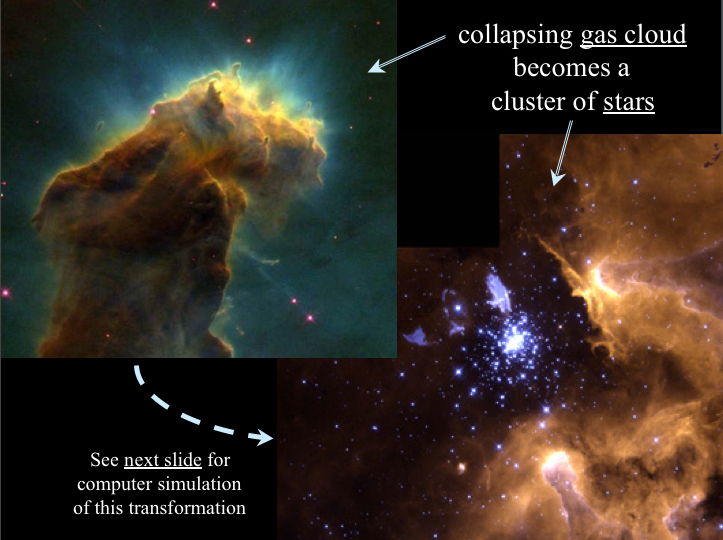
|
Does contemporary star birth resemble ancient star birth? Broadly yes, but in detail no. The most important difference was in composition: the first clouds were pure hydrogen and helium – no heavier elements had yet been created. Such pristine gas clouds form very massive stars which shine fantastically brightly, live short lives, and die in cataclysmic explosions which spew forth many new elements. The first wave of star formation was like a brilliant firework display, whose thunderous bursts provided the material which over time might become planets and people.
With typical star births taking thousands to millions of years, we obviously cannot follow these processes as they unfold in real time. What we can do, however, is bundle the necessary physics into a computer program and follow the process as a simulation of reality – hopefully an accurate one.
The movie below shows one such simulation by Matthew Bates. Strictly speaking, it aims to reproduce present day star formation, but the depiction can also suffice for ancient star formation. Notice how the initial, spherical, gas cloud quickly becomes clumpy and the first stars condense. In this particular model, the stars continue to gather gas as they zoom through the cloud, and after a million or so years a small cluster of stars has been created.
Formation of Star Cluster
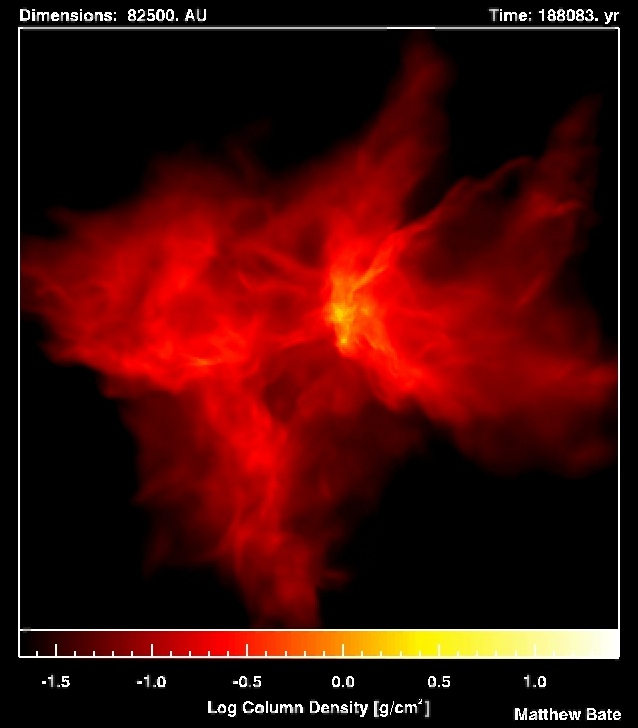 |
Run movie (careful: 53 Mb!!) (By Matthew Bate) |
While movies of this kind can give a feel for how the first stars might have been born, one should not take them too literally. In this case, for example, a number of effects which could be important weren't included, such as heating of the gas by star-light and star winds, while magnetic fields or rotation might complicate the collapse. Nevertheless, one can see how, in broad outline, a transformation from diffuse gas to individual stars comes about. For the first generation of stars, one should imagine this kind of transformation occurring across the entire Universe – a hundred million years of darkness brought to a close by the light of the first stars.
Where do the first stars form? In the regions of highest density – since these regions are first to turn around and collapse. Returning to our acoustic description, the densest regions are those where the peaks of small waves sit on top of the peaks of larger waves, which in turn sit on top of the peaks of yet larger waves – in other words, where the peaks from many waves coincide. This coincidence of location is what drives the hierarchy of assembly. The first stars are born in regions which are themselves over-dense and are about to turn-around and collapse, and these regions in turn are located in yet larger over-dense regions which will be the next to turn around and collapse. Thus, when the first groups of stars are forming, groups of these groups are already congregating and will ultimately merge to form a larger system. As time passes these larger systems in turn congregate and merge to form a yet larger system. And so it goes, from star clusters, to proto-galaxies, to galaxies.
One detail: the prime mover in all these mergers is dark matter — in fact the mergers are really between ever larger clumps of dark matter. Sitting within the dark matter clumps, however, are stars and gas and so these get carried along for the ride, making ever larger luminous systems. The scene to imagine, spanning the first billion years or so, is a Universe filled with ceaseless activity as countless mergers take place, gradually assembling ever larger systems.
Can we find any observational evidence for the story of gradual galaxy assembly? Yes! And, what's more, fairly direct evidence. Using telescopes to view the deep past, one finds that extremely distant – i.e. young – galaxies look quite different from nearby – i.e. old – galaxies. In particular, they tend to be smaller and less structured – more like galaxy building blocks than fully developed galaxies. These are structures caught relatively early in the assembly line – in time they will merge to make the larger galaxies we tend to see around us today.
Although the most intense period of merging occurred long ago, it continues even today when entire galaxies merge. Our own galaxy, for example, is currently devouring a small dwarf galaxy, while some of the most spectacular extragalactic images depict whole galaxies or groups of galaxies in the midst of merging as you can see from these images:

|
Since galaxy mergers can take 10 million years to complete, computer simulations allow us to follow their complex evolution. The simulation below shows how a group of merging small galaxies can result in a large one:
Merger of several small galaxies
 |
Run movie (9.4 Mb) (By Barnes & Hernquist) |
The merging process also spawns the birth of many new stars, as gas clouds collide and congregate at the centers of galaxies. Not only can we see this directly in nearby colliding galaxies, but there is much evidence that in the young Universe star birth rates were much higher, especially during the period when mergers were common. By comparison, we now live in a calm and quiet time, when the exuberant exploits of youth have given way to the more docile infertility of old age.
A key aspect of the hierarchical assembly of structure is that as time passes, ever larger regions halt their expansion, turn around, and collapse. This results in a steady increase over time of the size of the largest structures: after a hundred million years the first stars have formed; after a billion years the first galaxies have formed; and after a further eight or so billion years the first rich clusters of galaxies have formed. These clusters contain thousands of galaxies and seem to form at the intersection of great sheets of galaxies that constitute the galaxy web. The over-density of these intersections pulls galaxies into the apex where the cluster forms. One of these rich clusters is shown below, and a computer simulation of the cluster assembly process is shown below that. (The curious blue arc-like features seen in the cluster are in fact yet more distant galaxies, imaged imperfectly by the gravitational field of the cluster acting like a giant cosmic telescope lens).
Rich cluster of galaxies
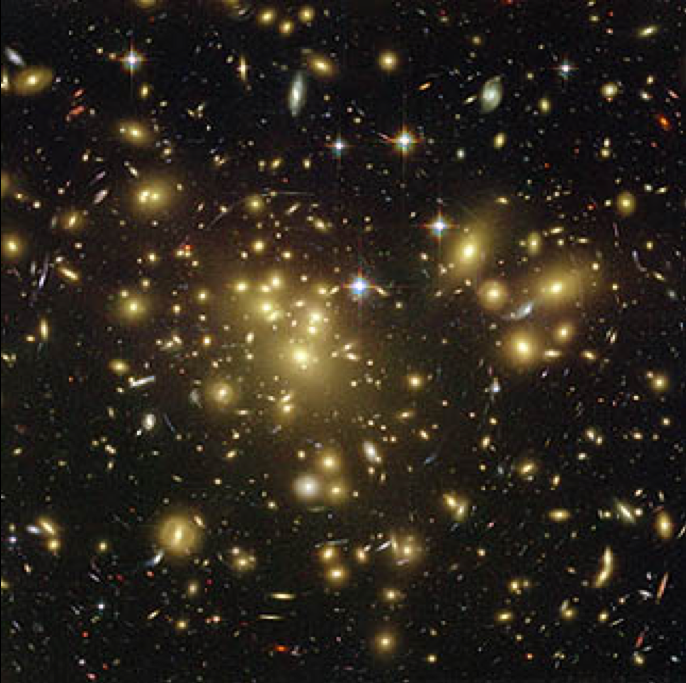
|
Simulation of cluster formation
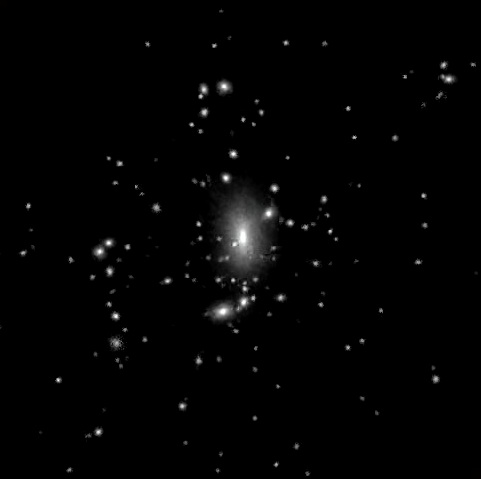
|
Run movie (2.7 Mb) (By Ben Moore) |
We live in an era of ongoing cluster assembly. All around us clusters of galaxies are being built: some young and loose others more mature and dense; an expanding sphere of influence pulls in surrounding galaxies for the first time; entire clusters can collide and merge in the most energetic events in the Universe. Within clusters, galaxies continue to interact and merge, in so doing changing their form, usually from delicate spirals to a robust elliptical which can sometimes grow to outsized and bloated proportions. The ongoing dance of galaxies is wild and wonderful.
Finally we come to the largest structures known. If the three previous structures - stars, galaxies, clusters - represent a house, a city and a state; then the galaxy tapestry represents the largest global structures: continents. In a sense, no larger structures exist – there hasn't been time for the hierarchy to reach beyond these enormous scales to build anything bigger.
What is the tapestry? Look at the next slide, which shows the positions of 300,000 galaxies in a thin wedge of the Universe: our own galaxy sits at the vertex while the radius length is nearly 3 billion light years. With the exception of a few bound clusters in the densest parts, all of these galaxies participate directly in the cosmic expansion and are very far from the time of turn-around and collapse. And yet the galaxy distribution is far from uniform – there are great chains (sheets in two dimension) of galaxies, as well as giant voids in the distribution. This filamentary structure has grown over time and reveals more or less directly the long wave patterns in density in the early Universe. In the slide following, you can see the growth of the tapestry structure in a computer simulation which includes nearly 10 million galaxies spanning a similar sized region. The tapestry provides a remarkable image – one can even sense the wave-like structures spanning the region, with the favored wavelength of the ancestral fundamental tone still visible.
Large Scale Galaxy Pattern
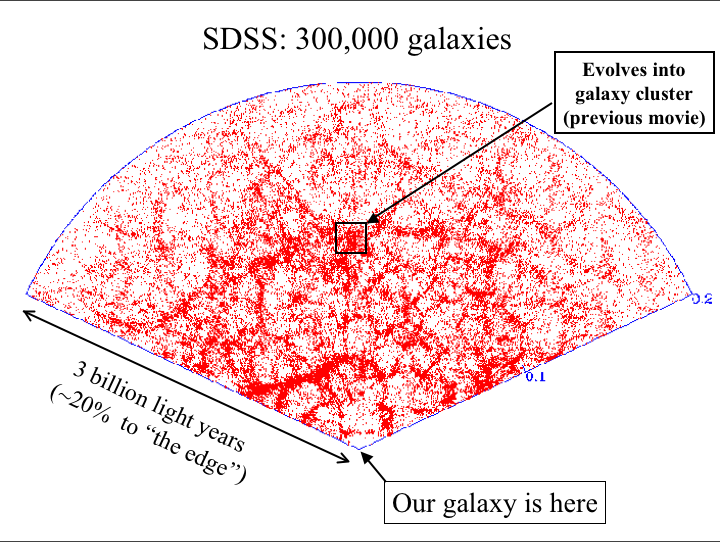
|
Simulation of structure formation
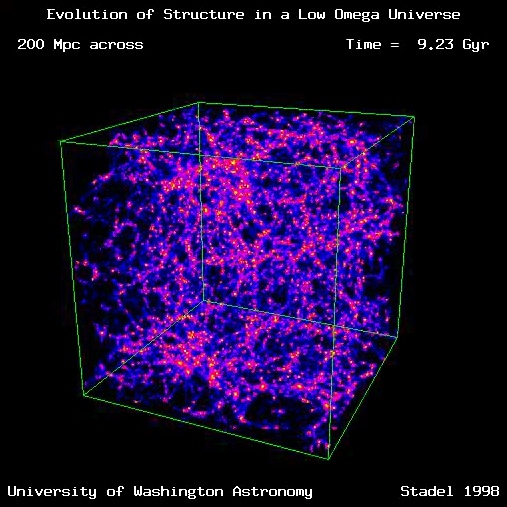
|
Run movie (7.5 Mb) (By Stadel) |
And so we return to the giant scales seen in the microwave background. The tapestry map covers 3 billion light years which corresponds to about 15 degrees on the CMB — roughly the size of the black square in the all-sky WMAP image shown in the image below. In linking the CMB and tapestry maps, you can think of the full 14 billion year evolution of the little black square as equivalent to the computer simulation of tapestry formation shown in the previous movie.
As you might imagine, this overlap in scales between the largest galaxy surveys and the highest resolution CMB maps is a crucial ingredient in understanding the evolution of structure in the Universe – we have a "before" and an "after" picture, and time alone should evolve the patchiness in the CMB black square into the pattern of galaxy dots in the tapestry map. Remarkably, analyzing the wave patterns in the tapestry map reveals the first (fundamental) harmonic seen in the CMB map – there really were sound waves back then, and they influenced just where galaxies would and would not end up.

|